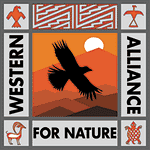
Photo #001: Narwhals
Narwhals, often referred to as "Unicorns" of the sea, reside in the Arctic Ocean.
They winter beneath the sea ice for up to five months in the Baffin-Davis Straight above the Arctic Circle. This photo was taken at the floe edge, where ice meets the sea in Baffin Bay.
The "tusk" is a protruding canine tooth that can reach up to 10 feet in length and acts as a sensory organ.
Narwhals are seriously threatened by climate change and oil and gas extraction.

Photo #002: Orcas Under Water
The largest member of the dolphin family, the Orca, is a powerful predator that preys on seals and sea lions as well as other whales. They range widely from pole to pole.
This photo was taken in waters of Antarctica.

Photos #003: Polar Bear
Considered the largest bear on earth, the Polar Bear lives in the Arctic and hunts seals on ice packs. However, due to global warming, sea ice is disappearing rapidly and the Polar Bear has been Federally listed as a threatened species. Scientists feel that by the end of this century, the Polar Bear will be extinct. It has become the icon of the detriment of climate change which not only impacts the Arctic but all latitudes.
This photo was taken in Hudson Bay where the population has already declined by 22% since the 1980's.

Photo #004: Jaguar
Jaguars, an apex predator and keystone species, have been completely extirpated from the United States. Go to our Jaguar project page to see how we are helping to restore the third largest cat in the world and largest cat in the Western Hemisphere.
This photo was taken in the Pantanal, Brazil

Photo #005: African Cinnamon-chested Bee-eaters
These picturesque birds occur along montane forest edges of Kenya, Tanzania and Uganda. This photo was taken in Uganda's Bwandi Impenatrable Forest National Park. There are 20 species of bee-eaters in Africa.

Photo #006: Horned Puffins
The Horned Puffin is an auk, and a pelagic sea bird that nests on rocky islands off the coasts of Alaska, Siberia and British Columbia. They over winter far out at sea. Their population is declining due to invasive species such as rats that have been introduced to the islands as well as climate change that affects their food sources.
This "puffin chorus line" photo was taken on a ledge on Round Island in the Bering Sea.

Photo #007: Ocelot Preying on Iguana
The Ocelot, also know as the "dwarf leopard" is a nocturnal small wild cat found from Mexico south to most of South America. It has been essentially extirpated from the United States except for an occasional rare sighting. The ocelot hunts small prey at night and hides during the day. This photo taken on Barro Colorado Island in Panama and is one of the only series of photos that documents an Ocelot hunting a Green Iguana during mid-day. Not only had hunting during the day never been observed before but that it would hunt an animal nearly its own size was unexpected. The series of photos that documented half hour of struggle between predator and prey was donated to Smithsonian Institude Ocelot researchers.

Photo #008: African Lion in Field of Wild Flowers
Lions are the only wild cats that live in family groups called "Prides". All other wild cats are solitary. The male lion fiercely defends the pride. Sporting a huge mane, the male lion can be intimitating but this photo conveys regal serenity as he rests in a field of wild flowers.
This photo was taken in the Serengeti, Tanzania

Photo #009: Brown Bear Fishing
The Brown Bear is the Polar Bear's closest relative and lives in lower latitudes. Subspecies include the Kodiak, which rivals the Polar Bear in size and the Grizzly which preys on elk, caribou and deer. The Brown Bears of Katmai National Park in Alaska catch Salmon. Perched precariously on top of Brooks Falls, catching leaping salmon as the fish migrate up river to spawn is a spectacle that delights photographers and annual visitors to the Park.

Photo #010: Andean Condor Soaring Over Antisana Volcano
The Andean Condor ranges along the length of the Andes in South America. It is the national symbol of Argentina, Bolivia, Columbia, Ecuador and Peru. Yet it is considered an endangered species due to loss of foraging habitat (condors forage over 150 miles per day) and due to secondary poisoning from carcases left by hunters and exterminators. Captive breeding programs are under way in some countries. In fact the captive breeding program for the California Condor was established by first experimenting with captive Andean Condors and the release of only females in the US and then later recapturing them and relocating them back to South America.
Along with the California Condor, they are some of the largest flying birds in the world.
This photo served as the "poster child" image for the campaign that succeeded in establishing a preserve around Antisana in Ecuador.

Photo #011: Trumpeter Swan
Trumpeter Swans were nearly extirpated in the lower 48 states of the US . A small population survived in Yellowstone but continues to decline. As of 2013 there were as few as 10 resident Trumpeters with only two breeding pairs in Yellowstone. The Trumpeter is North America"s largest waterfowl with a wing span of 8 feet.
This photo of the winged ballerina taken in Yellowstone National Park in winter demonstrates why swans have inspired ballets and dances.












